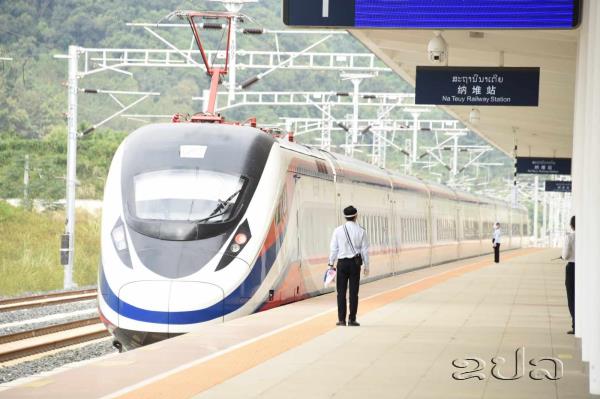KPL
Since its inauguration in late 2021, the Laos-China Railway has become a cornerstone of socio-economic growth in the Lao PDR, symbolizing enhanced connectivity, economic advancement, and regional integration.
Stretching over 1,000 kilometres from Kunming in China’s Yunnan Province to the Laotian capital, Vientiane, the railway is a flagship project of China’s Belt and Road Initiative (BRI). It has significantly promoted trade, tourism, and local livelihoods, underscoring its value to Laos.

Laos-China Railway Nateui Station, Luang Namtha/Photo by Aikham Khamlasy
By Sengthong Phasavath
(KPL) Since its inauguration in late 2021, the Laos-China Railway has become a cornerstone of socio-economic growth in the Lao PDR, symbolizing enhanced connectivity, economic advancement, and regional integration.
Stretching over 1,000 kilometres from Kunming in China’s Yunnan Province to the Laotian capital, Vientiane, the railway is a flagship project of China’s Belt and Road Initiative (BRI). It has significantly promoted trade, tourism, and local livelihoods, underscoring its value to Laos.
Driving Economic Growth
Since the railway became operational, exports to China have grown substantially. According to the Department of Foreign Trade under the Ministry of Industry and Commerce, Laos’ exports to China rose from US$2.22 billion in 2021 to US$2.23 billion in 2022 and US$2.50 billion in 2023.
In the first nine months of 2024 alone, exports to China reached US$1.78 billion. Imports from China also grew, from US$1.38 billion in 2021 to US$1.66 billion in 2022, US$2.39 billion in 2023, with the first nine months of 2024 already at US$2.35 billion.
This direct rail connection to China and beyond has lowered transportation costs, increased accessibility to international markets, and enabled smoother exportation of Lao products, including minerals and agricultural goods.
For example, Lao farmers now export fruits like durian, bananas, and watermelon to China with greater ease. Additionally, logistics within Laos have improved, with consumers in Vientiane able to receive goods from China within a week or two.
"The railway has made imported goods more affordable for Lao people,” shared Nang Heuangchan, a resident of Hadxayfong district in Vientiane, who recently purchased a trampoline from China. She paid around two million kip (US$90), including transportation.
Expanding Logistics and Construction Sectors
In Vientiane, new warehouses, delivery businesses, and commercial offices are sprouting around railway stations. The Thanaleng Dry Port, launched in late 2021, currently handles approximately 200 containers daily, processing nearly 50,000 containers bound for China and other countries last year alone.
These developments are positioning Laos as a regional logistics hub, attracting foreign investment and creating employment for Lao people.
Boosting Tourism
The railway has also spurred growth in the tourism sector. Offering a convenient travel option, the railway enables both locals and international tourists to explore Laos’ scenic landscapes and cultural sites. Hundreds of passengers use the Vientiane station daily, many travelling to popular destinations such as Vangvieng and Luang Prabang.
The number of Chinese visitors to Laos grew from over 45,200 in 2022 to more than 641,000 in 2023. In the first half of 2024, Chinese visitors reached 510,083, a year-on-year increase of 61%.
"I took my first train ride with my family to Vangvieng early this year," recounted Vilayvanh Phoutthavong. "It was an incredible experience, and I want more of my family to enjoy it too."
The railway has made it possible for travellers in Vientiane to visit cities in northern Laos and return within the same day—a convenience previously unimaginable.
Efforts to integrate the railway with other regional transport systems are also underway. In October 2023, Deputy Prime Minister and Foreign Minister Saleumxay Kommasith and his Thai counterpart, Parnpree Bahiddha-Nukara, discussed constructing a railway bridge over the Mekong River to connect Vientiane with Thailand’s Nong Khai Province. Talks also covered extending the cross-border railway from Nong Khai to Khamsavath Station in Vientiane to promote tourism and enhance access to the Laos-China Railway.
A Vision for the Future
The Laos-China Railway represents more than a transportation link between Laos and China; it marks a new phase in Laos' development. By connecting Laos to the wider region, the railway creates opportunities for economic growth, tourism, and cultural exchange. Thailand’s high-speed rail project, which will connect Bangkok with the Laos-China Railway by 2028, is expected to strengthen Laos’ position as a logistics hub in Southeast Asia.
As the railway continues to contribute to socio-economic development, especially for communities along its path, its long-term potential will likely transform Laos into a more connected nation and a vital player in the regional logistics landscape.
KPL